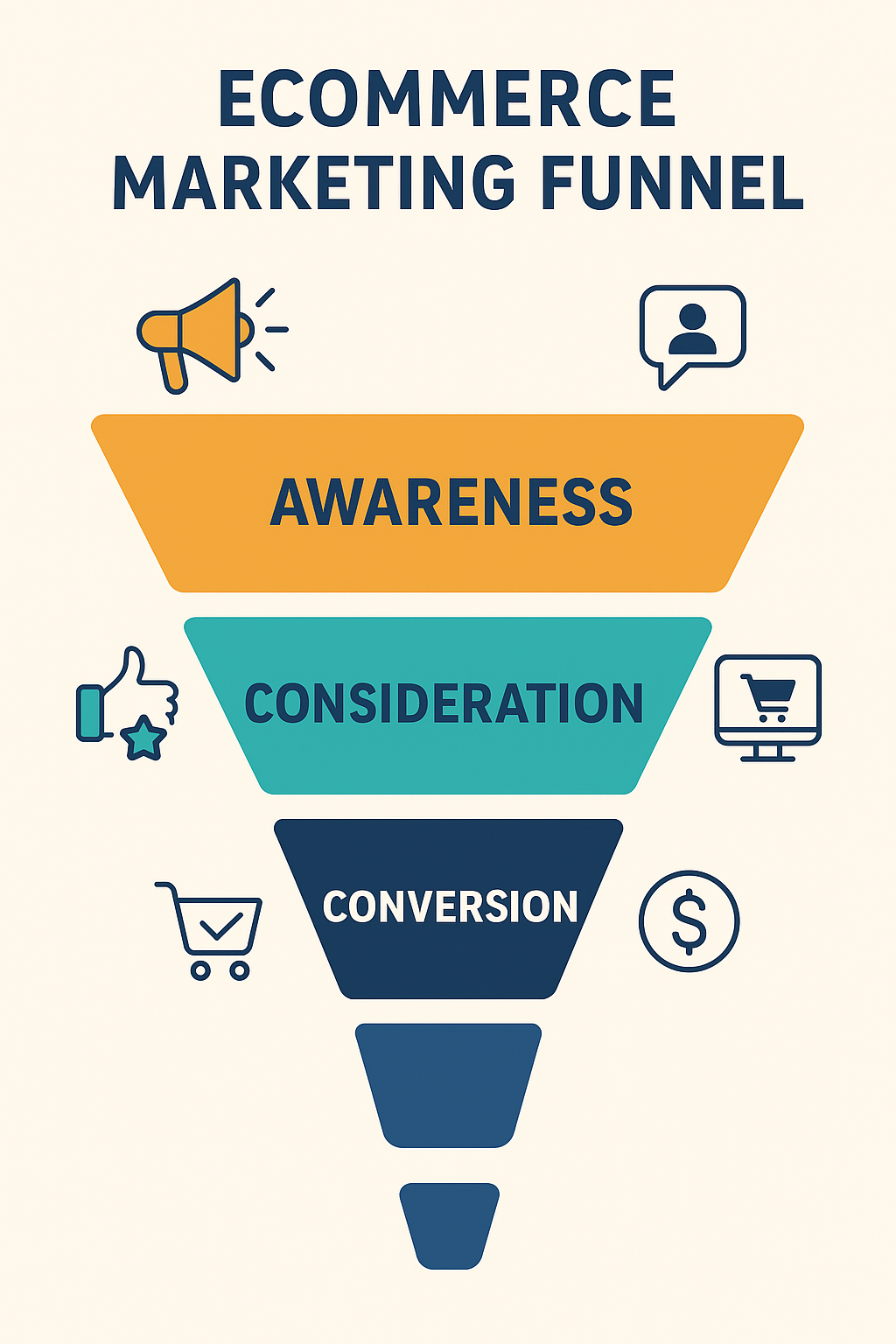The eCommerce marketing funnel maps the stages a potential customer passes through before, during, and after making a purchase. It provides a framework to align marketing activities with buyer intent, helping teams prioritize channels, messages, and metrics. Clear funnel thinking reduces wasted spend and improves the predictability of customer acquisition.
Top of Funnel Awareness
Brand awareness is the funnel’s widest point and focuses on reaching people who have never interacted with your store. The objective here is visibility: getting your brand, products, or value proposition in front of relevant audiences. Content at this stage should be high-value and low-commitment, designed to spark curiosity rather than push for a sale.
Content formats that work well at awareness include short educational videos, social posts, and blog content that addresses broad problems or trends. Success metrics are reach, impressions, and new traffic sources, which signal that your brand is being discovered by potential customers.
Middle of Funnel Consideration
Once awareness exists, the middle of the funnel moves people from casual interest to active consideration. This stage is about helping prospects evaluate options and see your product fit their needs. Tactics include email nurture sequences, retargeting ads, in-depth product guides, and webinars.
Messaging should emphasize benefits, comparisons, and evidence—reviews, case studies, and honest product demos. Metrics to watch are email open and click rates, time on product pages, and content engagement, which indicate progressing intent.
Middle of Funnel Trust and Qualification
Qualifying leads and building trust is a quieter but critical MOFU activity. Use segmentation and personalized messaging to address specific concerns, price sensitivity, or product fit. Tools like on-site chat, FAQ hubs, and downloadable spec sheets help prospects self-qualify and move closer to purchase.
Trust signals—transparent policies, social proof, and clear guarantees—reduce friction and perceived risk. Track form submissions, demo requests, and repeat visits to gauge whether prospects are becoming qualified buyers.
Bottom of Funnel Conversion
The bottom of the funnel is where purchase decisions are made; friction here directly reduces revenue. Focus on a seamless checkout, obvious calls to action, and reassurance through one-click returns, clear shipping details, and payment options. Simplicity and speed win conversions.
Conversion tactics include time-limited discounts, product bundles, and trust-focused copy near CTAs. Key metrics are conversion rate, average order value, and checkout abandonment rate, which directly reflect funnel effectiveness.
Cart Recovery and Final Nudges
Cart abandonment is a common bottleneck at this stage and offers a high-return area to optimize. Recovery emails, SMS reminders, and personalized offers can recapture willing buyers. Ensure your messaging is helpful, not pushy, and addresses common abandonment causes like shipping costs or checkout complexity.
Testing subject lines, offer sizes, and timing will reveal the best recovery mix for your audience. Measuring recovered revenue and incremental conversion lift shows whether these nudges pay off.
Post-Purchase Experience
A smooth post-purchase experience turns a transaction into the start of a relationship. Prompt order confirmations, accurate shipping updates, and an easy returns flow reduce buyer anxiety. Follow-up messaging that educates on product use increases satisfaction and reduces returns.
Collect feedback and surface customer support proactively when issues occur. Post-purchase metrics to monitor include repeat purchase rate, return rate, and customer satisfaction scores.
Retention and Loyalty
Retention converts one-time buyers into lifetime customers and is usually cheaper than acquisition. Loyalty strategies include rewards programs, personalized recommendations, and tailored offers based on purchase history. The aim is habitual repurchase and higher lifetime value.
Measure retention through cohort analysis, repeat purchase frequency, and average customer lifetime value to understand the long-term health of your funnel.
Advocacy and Referral
Satisfied customers can become powerful acquisition channels through referrals and user-generated content. Encourage reviews, enable easy referral sharing, and highlight customer stories. Authentic advocacy reduces acquisition costs and improves conversion quality.
Track referral counts, review volume, and the conversion rate of referred traffic to quantify advocacy’s contribution to growth.
Measurement and Attribution
Effective funnel management relies on clear measurement and proper attribution of marketing activities. Define primary metrics for each funnel stage and use consistent reporting to spot trends and bottlenecks. Attribution models should reflect how your customers actually interact with multiple touchpoints before buying.
Combine quantitative data with qualitative signals—customer interviews or session recordings—to get a fuller picture of where prospects drop off and why.
Testing and Optimization
Continuous testing keeps the funnel performant as markets and customer behaviors shift. Prioritize experiments that target the biggest drop-offs or highest-value opportunities—homepage messaging, checkout UX, and email funnels. Use controlled A/B tests and iterate rapidly on winners.
Document learnings and roll out improvements systematically to avoid losing incremental gains or introducing regressions.
Personalization at Scale
Personalization increases relevance across the funnel by tailoring offers, content, and timing to segments or individuals. Start with simple rules (e.g., previous purchases or cart contents) and gradually introduce predictive personalization using behavior patterns. Even modest personal touches can lift engagement and conversion.
Respect privacy preferences and be transparent about data use; personalization works best when customers understand its benefits.
Cross-Channel Coordination
A funnel that spans search, social, email, and on-site experiences needs coherent cross-channel coordination. Ensure messaging and creative align across touchpoints so prospects receive consistent information as they move through stages. Use retargeting and sequential creative to tell a cohesive story rather than repeating the same ad.
Integrated planning reduces wasted impressions and helps attribution by creating predictable pathways to purchase.
Strategic Roadmap and Budgeting
Finally, treat the funnel as a strategic roadmap for resource allocation: invest where marginal returns are highest and where data shows the biggest bottlenecks. Balance short-term conversion tactics with long-term brand building to sustain growth. Regularly revisit priorities as performance and market conditions change.
A disciplined funnel strategy combines measurement, experimentation, and clear ownership to turn marketing activity into predictable revenue.
